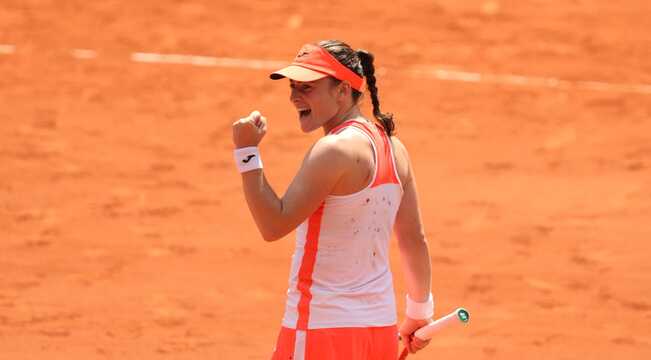New Delhi, June 08, 2021: Two of the last four women to triumph at Roland Garros had never won a tour-level title until lifting the Coupe Suzanne Lenglen. Could world No. 85 Tamara Zidansek be next?
The lone player left in the field without a WTA trophy to her name, and in a record group of six first-time major quarterfinalists, Zidansek is now two wins away from matching the unlikely feats of 2017 titlist Jelena Ostapenko and 2020 winner Iga Swiatek. On Tuesday, the 23-year-old Slovenian rose to the occasion by defeating No. 33 seed Paula Badosa, 7-5, 4-6, 8-6, in extending her history-making run.
“It sounds crazy, even to me. Right now, I’m going to try and focus on the next match,” Zidansek, a former junior snowboarding champion, told Tennis Channel afterwards.
Throughout the tournament, Zidansek has showed tremendous resolve. In the first round, No. 6 seed Bianca Andreescu served for their match. Zidansek prevailed, 9-7, in the third. In the third round, Katerina Siniakova raced out to a 6-0 lead. Zidansek turned the tide to claim the next two sets, 7-6 (5), 6-2. In the fourth round, she faced a set point against Sorana Cirstea. Zidansek won another crucial tiebreak, then stepped on the gas to close out the Romanian with a 6-1 set.
Against Badosa in the quarterfinals, Zidansek found herself down an early double-break in the first set—and faced three break points late in a thrilling decider.
Returning to begin the contest, Badosa saw an open space on her opponent’s forehand wing and put enough measure behind her backhand up the line to clinch the opening game. But once Zidansek shook off a nervy start in falling behind 0-3, she emerged as the risk-taker that had led her to this momentous occasion. She became the player looking to hit through her the court and use her footwork to get optimal strikes on her forehand. Badosa’s best opportunity to regain control came in the eighth game when serving at 4-3, 30-15, but her reluctance to pull the trigger cost the incoming Belgrade champion dearly.
At 5-5, deuce, a fired up Badosa believed she set up break point with another backhand down the line. Chair umpire Carlos Ramos overruled when he stepped down to check the mark, leading to a surprising symmetric finish to the set. Zidansek held with a well-disguised forehand drop shot winner and Badosa was broken with a poorly-carved backhand drop shot error. Zidansek’s one-set lead was built on a five-point advantage in the stat sheet, no coincidence given her 15 winners to 10 unforced errors differential.
Badosa didn’t go away quietly, crucially forcing the other side of the net to maintain her presence. Twice down a break, Badosa wiped away the deficit each time, and put an unsportsmanlike conduct warning behind her to level for 4-4. Zidansek’s nerves crept in, and Badosa pounced. Breaking at love to put the set on her racquet, the Barcelona resident closed with confidence to get herself into a third successive three-setter.
As the third set began to take shape, both players had to navigate the weight of the moment. Having lost six games in a row, Zidansek stopped the bleeding to get back on serve for 2-2. With Zidansek’s fighting spirit reinvigorated, the pressure shifted back to Badosa, who had the task of serving from behind.
Outside of one deuce game, the two went on a stretch of eight comfortable holds until 6-6. At 15-30, Zidansek tossed in her first double fault of the set. She relied on the shot that propelled her to this point, the forehand, to save both break points with winners. Another double fault came and another winning reply followed. With the crowd understanding the significance of this moment, the two competitors were encouraged to dig deeper.
A 16-point battle went the way of Zidansek, who clocked her sixth winner of the game to move ahead 7-6. Badosa fell behind 15-40, and on her second match point, Zidansek fittingly delivered one final forehand blow to seal the victory after two hours and 26 minutes according to the reports published in tennis.com.
“I knew that I can do a lot of damage with my forehand,” Zidansek told press afterwards. “I’ve just got to get into the right position. That’s exactly what I managed to do.”
Said Badosa in defeat, “I didn’t feel myself in the whole match. I’m a little bit sad about that, because I think I played maybe the worst match of the tournament and of the clay season, but sometimes it’s like that.
“I think I was very nervous.”
When Badosa’s name was moved to the bottom quarter after Alison Riske withdrew, there was a buzz surrounding the 2015 Roland Garros junior champion that she just might be a dark-horse pick to reach the semifinals. The likelihood of this scenario playing out increased exponentially when sixth seed Bianca Andreescu and past semifinalists Kiki Bertens, Johanna Konta and Amanda Anisimova were all sent packing in the first round. Second seed Naomi Osaka, who had never been beyond the third round, withdrew following her opening match.
After advancing to the third round without much resistance, Badosa staved off match point to topple Ana Bogdan in one of the clashes of the tournament. Next, she took down 2019 finalist Marketa Vondrousova in the round of 16.
Yet it’s Zidansek, the first woman representing Slovenia to reach a major singles quarterfinal—and now a semifinal—who awaits the winner of No. 21 seed Elena Rybakina and No. 31 seed Anastasia Pavlyuchenkova for a shot at playing for a piece of Grand Slam hardware.





























